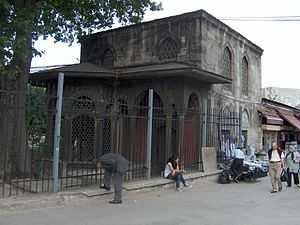Fatma Hatun
| Fatma Hatun | |
|---|---|
| Born | Fatma |
| Died | Istanbul, Ottoman Empire |
Resting place | Istanbul |
| Residence | Istanbul |
| Ethnicity | Croatian |
| Religion | Islam |
| Spouse(s) | Ahmed I |
| Children |
Şehzade Cihangir Şehzade Hasan Şehzade Selim Şehzade Orhan |
| Parent(s) | Kuyucu Murad Pasha |
Fatma Hatun was the second wife of Ottoman Sultan Ahmed I and the mother of Şehzade Cihangir, Şehzade Hasan, Şehzade Selim and Şehzade Orhan.

Biography
Fatma Hatun was born to Kuyucu Murad Pasha,[1][2][3] who served as grand vizier of the Ottoman Empire during the reign of Ahmed I between 9 December 1606 and 5 August 1611.[4] She was married to Ahmed in 1604. She was the second of Ahmed I's three women and bore him four sons, Şehzade Cihangir, Şehzade Hasan, Şehzade Selim and Şehzade Orhan, but all of them died in infancy.
Venetian ambassador Simon Contarini, in his 1612 reports, suggests an incident that Fatma Hatun, like Akile Hatun, the wife of Ahmed's successor, Osman II and the daughter of Şeyhülislam Hacı Mehmed Esadullah Efendi, never entered the Imperial Harem.[4] According to Contarini, when roughly a decade earlier Fatma Hatun had wanted to enter the harem of Sultan Ahmed I, the harem stewardess (kethüda kadın) had discouraged her by arguing that she would loose her mind among so many slaves and her sons would probably be killed through the practice of fratricide.[5][4]
It is also possible that she was banished from the harem like Mahfiruz Hatice Sultan, Ahmed's first wife and the mother of Osman II,[4] or that the prospect of the daughter residing within the imperial harem may have been an important element in the unpopularity of the marriage.[4]
See also
- Ottoman Empire
- Ottoman dynasty
- List of Valide Sultans
- List of sultans of the Ottoman Empire
- Line of succession to the Ottoman throne
- List of consorts of the Ottoman Sultans
Further reading
- Peirce, Leslie P., The Imperial Harem: Women and Sovereignty in the Ottoman Empire, Oxford University Press, 1993, ISBN 0-19-508677-5 (paperback).
- Yavuz Bahadıroğlu, Resimli Osmanlı Tarihi, Nesil Yayınları (Ottoman History with Illustrations, Nesil Publications), 15th Ed., 2009, ISBN 978-975-269-299-2 (Hardcover).
References
- ↑ Necdet Sevinç, Osmanlı sosyal ve ekonomik düzeni
- ↑ Türk Tarih Kongresi (12, 1994, Ankara), XII. Türk Tarih Kongresi: Ankara, 12 - 16 Eylül 1994 : kongreye sunulan bildiriler
- ↑ Mehmet Aydın, Konya merkezindeki manevi halk inançlarının dinler tarihi ve din fenomenolojisi açısından değerlendirilmesi
- ↑ 4.0 4.1 4.2 4.3 4.4 Leslie P. Peirce (1993). The Imperial Harem: Women and Sovereignty in the Ottoman Empire. Oxford University Press. pp. 106–107. ISBN 9780195086775.
- ↑ Barozzi and Berchet. Le Relazioni. 1:131